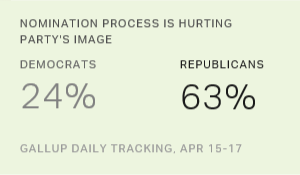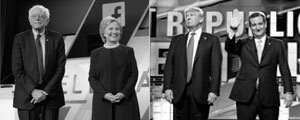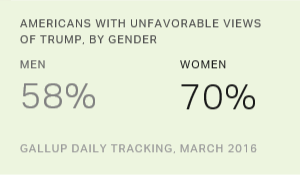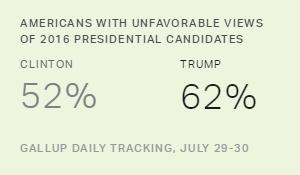How similar are the images of Donald Trump today and Ronald Reagan at the comparable point back in 1980? One of the most striking aspects of Trump's journey to front-runner status in the GOP campaign has been his extraordinarily negative image -- as of today, 63% unfavorable compared with 32% favorable among the general population. Did Reagan also have a strongly negative image in 1980, only to overcome it and win the presidency?
A writer with Gateway Pundit recently cited a tweet from prominent political commentator Ann Coulter, which in turn cited an April 15, 1980, Washington Post article written by Bill Peterson, which in turn cited in its final paragraph a March 25, 1980, Los Angeles Times poll showing Reagan's favorable image at 30%. This final 30% number was used in the first two of these publications to bolster the hypothesis that Trump is merely following in Reagan's hallowed footsteps.
Peterson's description of the poll in the 1980 Washington Post article is worth reviewing:
"The other poll was taken by the Los Angeles Times on March 25, the day of the New York primary. It asked Republican and Democratic voters to record favorable and unfavorable impressions of candidates. Anderson finished in the poll with a 68 percent favorable rating. Sen. Edward M. Kennedy was second with a 60 percent favorable rating followed by President Carter with 51 percent and Ronald Reagan with 30 percent." It was this 30% number that Coulter picked up and, eventually, the Gateway Pundit.
We were not able to find a national Los Angeles Times poll conducted on March 25. Several Los Angeles Times national polls archived in the Roper Center from 1980 measured Reagan's image. But none were conducted in March 1980. And none, something we will come back to shortly, showed Reagan with a 30% favorable rating.
In fact, the more we look at the data described in the 1980 Washington Post article, the more it appears that this author was referring to a Los Angeles Times exit poll of New York state primary voters. The New York primary was on March 25; there was a Los Angeles Times exit poll conducted then, and the article's wording refers to Republican and Democratic voters, although the author did not label it as an exit poll per se. We were able to locate the data from the Los Angeles Times New York exit poll from March 25 from the Roper Center archives. This shows Reagan with an overall 35% favorable rating -- similar to but not the same as the 30% reported in the Washington Post article. So there remains a mystery as to the origin of the 30% number cited in the Washington Post article. But regardless, these data are from New York state voters, who constitute a substantially different group than the national population with which it is being compared -- not a useful comparison.
There are, in fact, a number of traditional, national poll results from 1980 which did measure Reagan's image. In general, these data show that Reagan enjoyed mostly positive net favorable reviews throughout 1980.
Gallup's 10-point "scalometer" method of measuring favorability found 70% of Americans viewing Reagan positively in May and August of 1980. And while the scalometer rating tends to produce higher favorable scores than binary favorable/unfavorable scales, Reagan earned a 60% favorable rating in a January 1980 Gallup/Newsweek poll using the binary wording.
A multitude of polls by other firms whose surveys are archived in the Roper Center polling database confirms Reagan's generally positive 1980 image.
The Los Angeles Times national polls all show that Reagan's image was more favorable than unfavorable, including polls in the fall of 1979 and in June, September and October of 1980. There is no Los Angeles Times poll which can be located from 1980 that shows Reagan with a more unfavorable than favorable image, as is the case with Trump today.
The New York Times/CBS poll provided the best time series of image assessments of Reagan throughout 1980. These polls showed Reagan's favorable rating exceeding his unfavorable rating in each poll conducted in 1980 -- with the exception of September's poll, in which the two figures were even, at 38%. Reagan's image was the most positive in the early months of the year, including polls conducted in January, February, March and April where his favorable rating was always above 50% and his unfavorable at least 19 points lower, with a consistently high "don't know/unable to give an opinion" response percentage. His image dropped later in the year as the campaigning became more intense, but as noted, never moved into net negative territory in the New York Times/CBS polls. The Roper database shows one poll, conducted by NBC News/Associated Press, showing Reagan with a 52% favorable and 35% unfavorable image.
Only one organization's polling -- Cambridge Reports -- consistently showed Reagan's image with a somewhat less favorable tilt, including a 41% favorable/44% unfavorable rating in January 1980, a 39% favorable/44% unfavorable rating in April and a 35% favorable/49% unfavorable rating in July. But by October, Cambridge Reports gave Reagan a 51% favorable. From this time distance, it's not possible to determine why this one organization's polling was so out of sync with the others conducted roughly contemporaneously. But even the Cambridge numbers for Reagan were not nearly as negative as Trump's overall image is today, with their "worst" assessment showing a -14 net favorable, compared with Trump's consistent net favorable ratings of -30 or worse today.
The impulse to compare Trump today to Reagan in 1980 is curious on the basis of the available favorability data. But it makes some sense in context of the historical associations Reagan carried into the 1980 campaign. His entry into the California governor's race in 1966 was met with much well-publicized skepticism about his background as a Hollywood "B-movie" actor. Incumbent Gov. Pat Brown was reportedly giddy over the seeming ridiculousness of running against "this politically inexperienced, right-wing extremist and aging actor." By the time Reagan ran for president in 1980, he had a record as a successful two-term governor of the nation's largest state and had run a credible challenge to Gerald Ford for the Republican nomination in 1976 as the darling of the conservative wing of the party. Some of the derision he faced in 1966 still lingered in 1980. Even as late as September 1980, Gallup found a majority of Americans associating Reagan with "putting his foot in his mouth." And it is perhaps the memory of these types of concerns which has given rise to current comparisons between Trump's current bid for the presidency and Reagan's in 1980.
But in terms of image comparisons, the poll evidence shows that at this time in the 1980 campaign year, Reagan's image was significantly more positive than Trump's image is at the same time in the 2016 campaign.



